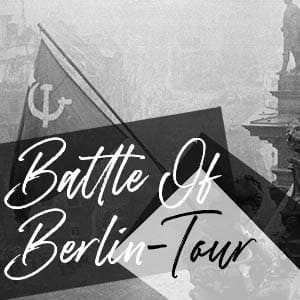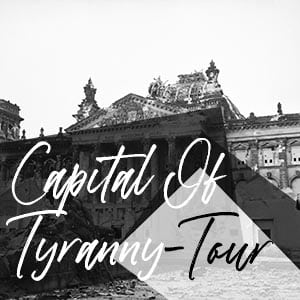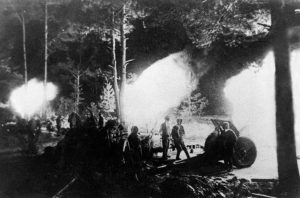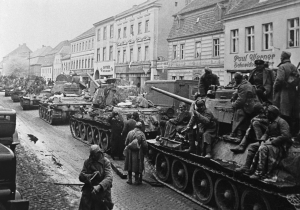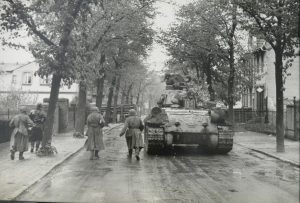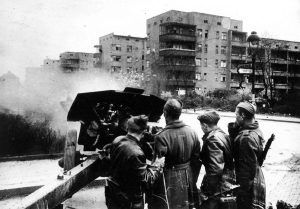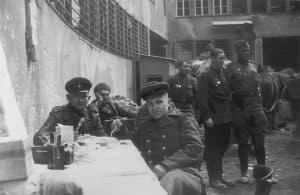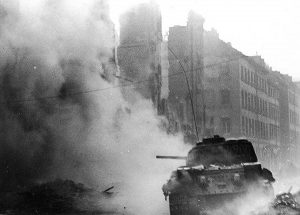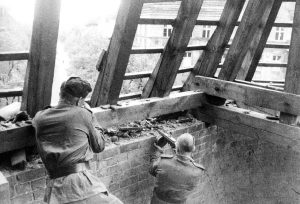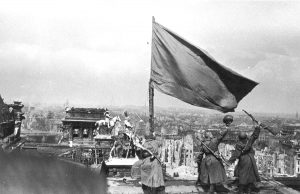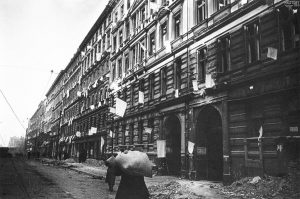At around 3:30am on May 1st 1945, German General Hans Krebs met with Vasily Chuikov, head of the Soviet 8th Guards Army, to attempt to negotiate a ceasefire. Krebs also gave Chuikov news of a certain event that had transpired some 12 hours earlier in the Führerbunker – contained in a document signed by Joseph Goebbels and Martin Bormann.
Adolf Hitler, the leader of Nazi Germany, was dead.
Feigning prior knowledge, Chuikov replied that the Red Army was already aware, before relaying this news to Georgy Zhukov, who contacted Joseph Stalin. The Soviet leader immediately refused the German attempt to arrange a ceasefire – demanding nothing short of unconditional surrender.
Stalin would then return to bed and insist on not being disturbed, in order to rest to be prepared for the May Day celebrations in Moscow. The Generalissimo would watch the parade on Red Square, the capital’s garrison filing past, the Soviet leaders gathered at Lenin’s Mausoleum. To celebrate the day that Stalin hoped would coincide with the Soviet victory in Berlin, NKVD chief Lavrenti Beria had even lifted the curfew in the capital – especially for the celebrations.
One day before the capitulation of the city of Berlin, fighting continued. But in a strange atmosphere of celebration and exhaustion – as intoxicated Red Army soldiers slumped over against crippled buildings, passed out on pavements and intermingled with the corpses of their fallen comrades. The dust of ruined buildings blowing through the streets, leaving the few remaining defenders – now numbered in the thousands – red eyed from the harsh air and smashed by the waves of defeat.
Regular Red Army units carried out coordinated assaults on entrenched defenders but the rigidity of the formations parading in the Russian capital – to celebrate May Day for the first time in four years of the Great Patriotic War – would have little in common with their comrades still slugging it out in Berlin.
Or the improvised celebrations taking place across the city for International Workers Day.
For the remaining defenders of the Nazi capital – there was little to celebrate on May 1st.
The 8th Guards Army headquarters at Schulenburgring on the west side of Tempelhof airport, had already acquired a party-like atmosphere for May Day – which would cease, at least temporarily, for the German negotiations. Chuikov had reportedly been celebrating with the writer Vsevolod Vishnevsky, the poet Dolmatovsky, and the composer Blanter, who was in Berlin to compose a victory song. As the German delegation arrived, Blanter would be pushed into a cupboard and hidden as the remaining pair were left to stand and pretend to be staff officers – wearing the uniforms they had been given as war correspondents.
The Soviet demands were made clear to the remaining members of the Berlin government in the Führerbunker when Krebs returned and handed Joseph Goebbels a sheet of paper he had received from Chuikov. It read:
- Berlin surrenders
- All those surrendering must lay down their arms
- The lives of all soldiers and officers are to be spared
- The wounded will be cared for
- There will be an opportunity to negotiate with the Allies by radio
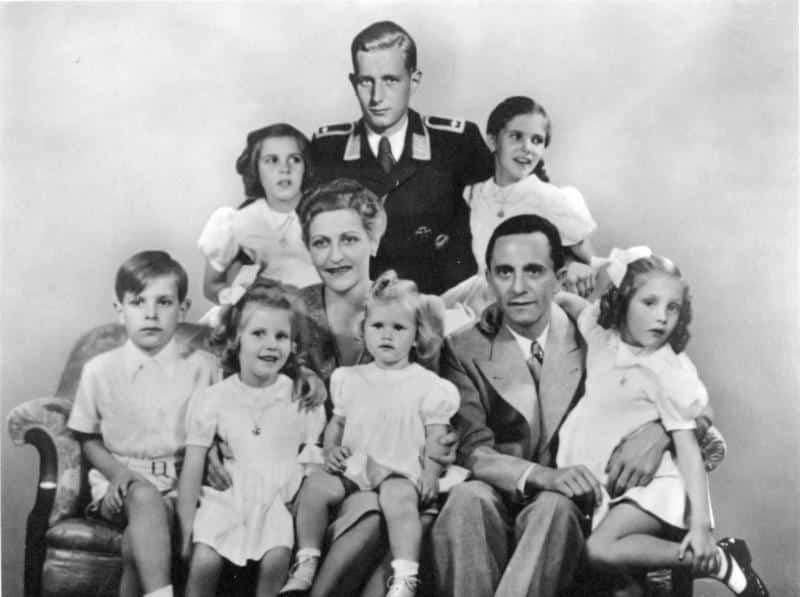
To Goebbels, the man who had delivered Berlin to the Nazi Party, from the Communists, in the 1920s and 30s, surrendering his hard earned gains now would be unthinkable. In 1926, Goebbels was appointed Nazi Gauleiter (district leader) of Berlin and had taken over control of the Sturmabteilung (SA) and Schutzstaffel (SS) in the German capital – making him answerable only to Hitler.
Violent attacks on Communist Party members and organised street brawls coordinated by Goebbels would soon gain the fringe Nazi Party attention and an increased following in Berlin. Despite the party being banned from the city in May 1927 and over 120 libel cases pending against Goebbels personally, the Nazis still stood for election the next year and Goebbels was elected as a member of parliament.
The results for the Nazi party were disastrous, as it lost over 100,000 voters and only received 1.4% of the vote.
But Goebbels acquired immunity from prosecution for a long list of standing charges.
By 1930, Berlin held the second largest number of voters for the Nazi Party – and an election following the collapse of the previous government saw Hitler’s party receive 6.5 million votes nationwide to become the second largest party in parliament.
The same year, Goebbels became the Nazi Party’s Reich leader of Propaganda – a position he would assume on a national level when Hitler’s government would seize power in 1933.
Intrinsic to Goebbels rise was his use of sloganeering, provocation, and the smoke and mirrors of choreographed political intrigue.
Like Hitler, he would practice his public speaking in front of a mirror.
The two would embrace the same language: anti-Semitic, anti-Bolshevik, and aimed at enemies in ‘International High Finance’ and the ‘November Criminals’.
The two would also share the same fate.

With no possibility of a peaceful resolution to the situation in Berlin on May 1st or the continuation of the ‘true’ National Socialist government, Joseph Goebbels would prepare his own suicide and the death of his family.
At around 8:30pm, Joseph and Magda Goebbels ended their own lives – mostly likely taking cyanide – after organising the poisoning of their six children in the Führerbunker.
In the evening of May 1st, Magda Goebbels had summoned a man named Helmut Kunz, adjutant to the head doctor of the SS medical administration, and asked him to give a shot of morphine to each of her children – Helga, Hilde, Hellmut, Holde, Hedda, and Heide. Once immobilised, Hitler’s own physician Dr Ludwig Stumpfegger crushed a cyanide capsule in the mouth of each child.
The Soviet soldiers who discovered the bodies of Joseph and Magda would have little difficulty identifying the remains when they entered the Chancellery gardens the next day; as there was not enough petrol left after burning Adolf Hitler and his wife Eva to ensure the complete disfigurement or disintegration of the Goebbels couple.
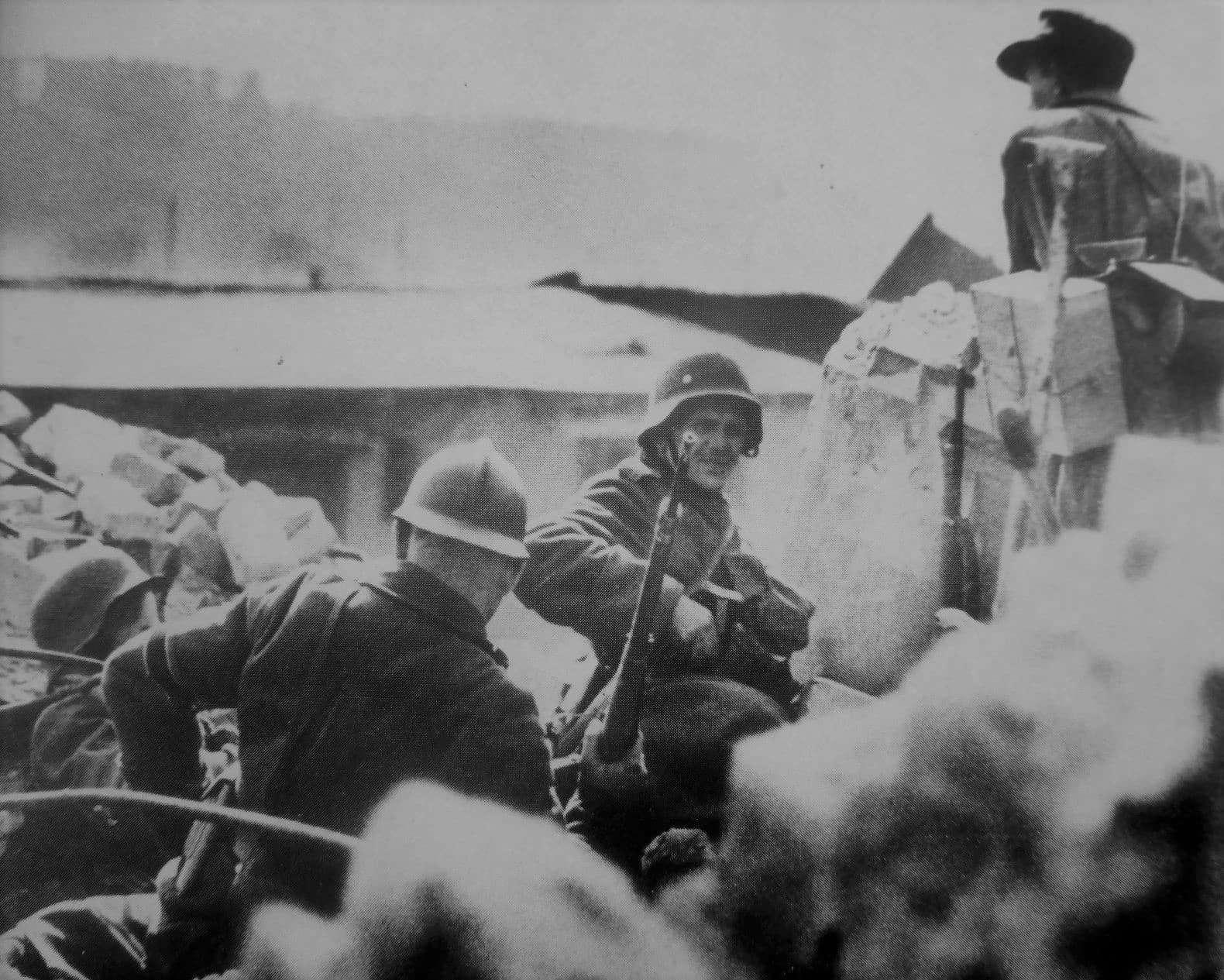
Despite the ceasefire negotiations taking place in the west of the city, fighting continued in Defence Sector Zitadelle throughout the day, as the 3rd and 5th Shock Armies and 8th Guards Army of the 1st Belorussian Front maintained their stranglehold of the city centre. Blasting away at ruined buildings and repulsing the final counterattacks.
94th Guards and 266th Rifle Divisions took the Zeughaus and State Library on Unter den Linden and moved west along this main city artery towards the Brandenburg Gate. The 416th and 295th Rifle Divisions would take the Opera House and the Reichsbank, with the unit commanders describing the advance:
“In the morning, the free subunits of the battalion gathered in a semi destroyed paper factory. The battalion commander read the Commander in Chief’s First of May order. Troops, sergeants and officers, in front of the formation gave a ceremonial oath that in the assault before them this morning they would justify Comrade Stalin’s trust.
They went into battle straight from the meeting. All of May 1st was spent in tense battles. The battalion subunits that were going to the State Opera cleaned the enemy out, building by building, block by block. The Germans stubbornly resisted on Niederwallstraße and on Kurstraße, which was parallel to it. Here they had put together a strong group overnight including up to ten self-propelled guns and armoured vehicles with missile launchers.
The Germans defended themselves desperately but, afraid that they were going to be completely surrounded, started to go along Jägerstrasse and Taubenstrasse towards the theatre. The assault groups, without allowing the enemy to figure out what was going on, burst into the theatre behind them. In a large building, they fought with the enemy in the darkness using shovels, knives, and hand grenades. After a half hour, it was all over.”
Soldiers from various different Soviet units managed to reach the Brandenburg Gate by the last afternoon and unfurled a red banner which was then placed in a hole in one of the bronze horses atop the monument.

In the distance, fighting for the Reichstag was closer to reaching its bloody conclusion.
By late afternoon on May 1st – more than 12 hours since the red banner had flown on top of the building at 10:50pm on April 30th – Soviet troops had finally managed to fight off the numerous counterattacks and attempts to relieve the building’s defenders and were attempting to force the surrender of the remaining fighters holed up in the cellar. The German troops left would pull out in the evening and filter away north – attempting to break out of the city. However the building would not be cleared completely until around 4am on May 2nd, following several negotiation attempts
Due to heavy losses sustained in the western part of the city, the 1st, 2nd, and 3rd Polish Infantry Divisions had been brought forward and helped bail out a halted Red Army tank attack on the Reichstag on May 1st. Spread through the western part of the Tiergarten, the Polish troops would raise their country’s flag on the Siegessäule victory column the next day.
The Hotel Adlon – and its improvised hospital with around 1,200 wounded – fell on May 1st. The Reich Main Security Office (SS-Gestapo headquarters) on Prinz-Albrecht-Strasse was finally abandoned by the remaining staff, Latvian foreign fighters, and SS-Charlemagne men defending the area – leaving the few remaining prisoners there to be discovered by Red Army soldiers early the next day.
Kriegsmarine troops previously tasked with defending Potsdamer Platz would rush over to one of the few remaining strongpoints in the city at Spittelmarkt and join the surviving Hitler Youth in the area. Gathering a force of around 2-300 men, the group commander organised a counterattack to clear the Soviets out of the area that lasted into the evening – destroying eight or nine tanks in the process.
Further west, negotiations for the surrender of the Spandau Citadel took place on May 1st – after this 17th century moated fortress was surrounded by the 47th Army the previous day. Loudspeakers had been brought forwards by the Soviet 7th Department – specialising in propaganda – calling on the defenders to surrender. Neither the Soviets investing the fortress nor the men, women and children inside were aware of Hitler’s death and the futility of their fight. For Hitler had personally stated that anyone caught surrendering a fortress should be shot – and the SS holed up inside were reluctant to let the citadel fall into Soviet hands.
Under the circumstances it could have taken another week for the Red Army to storm the object – considering its fortifications. In the afternoon on May 1st – around 3pm – the soldier, officers, and trembling civilians came out of the front gate of the citadel in columns. Among the mass of faces were two unusual characters by the names of Professor Dr Gerhard Jung and Dr Edgar Koch who had been working at the Army Gas Defence Laboratories in the fortress. Specialists in the development of Sarin and Tabun nerve agents, they were promptly whisked off into NKVD custody.
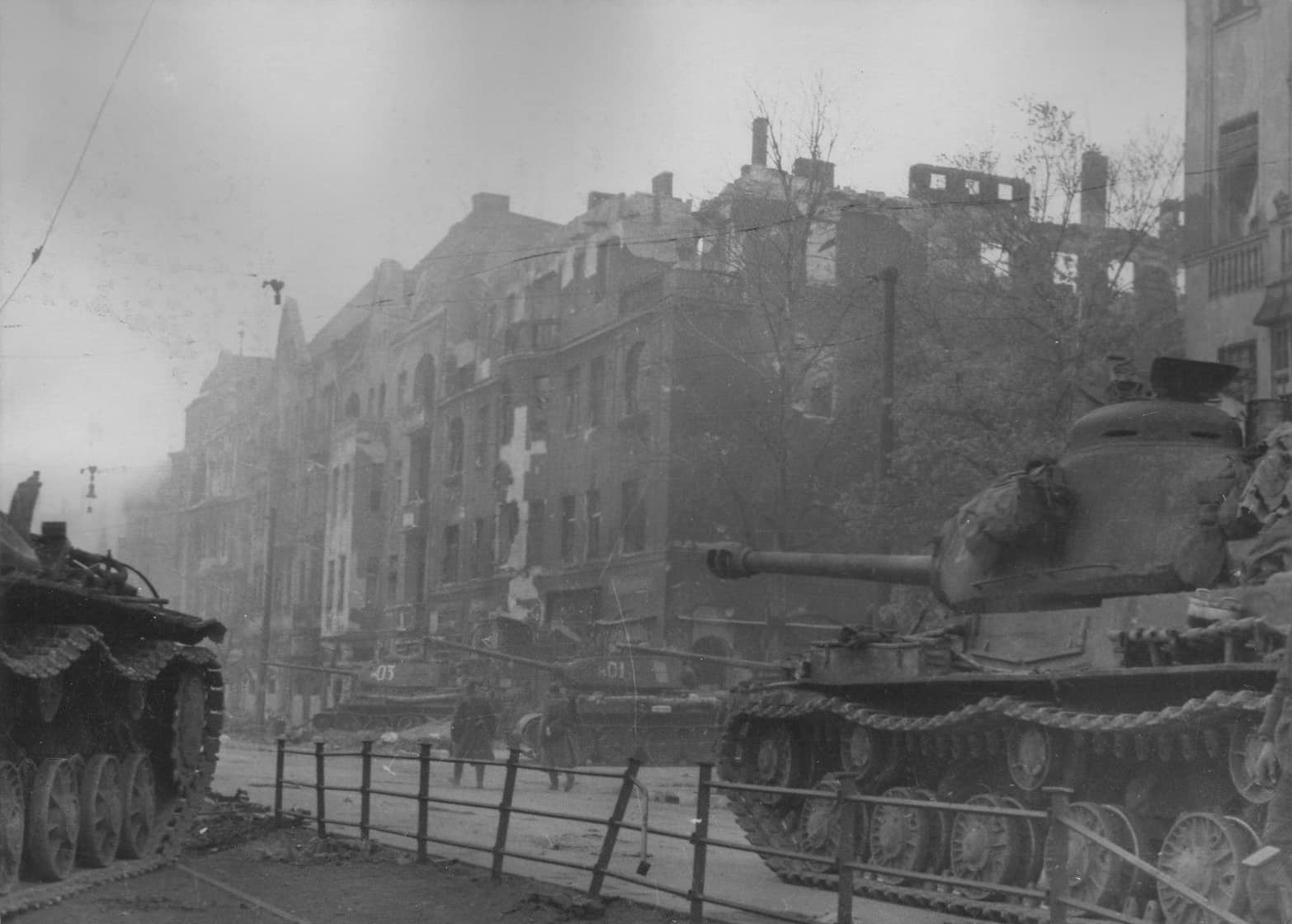
The Kaiser-Wilhelm-Gedächtnis-Kirche at the eastern end of the Kurfürstendamm finally fell on May 1st – after changing hands numerous times during clashes in the district of Charlottenburg. From this position the Soviet spotters and snipers gained a clear view into the Zoologischer Garten and the Zoo Flak tower, where an attack was already underway.
Reporting on the combat in the Zoo, a captain of the Soviet 28th Guards Rifle Corps, would state:
“At 3am, we started attacking. The Germans took up defensive positions in small groups of two or three at various points in the zoo, in the caves for the wild animals and in ditches. The wild animals were running around the zoo. Along with the firing, we again heard the roar of the tiger, the howl of the jackal, and the meowing of wild cats. Someone noticed some sort of figure in a tall branching tree and decided it was an enemy sniper – a ‘cuckoo’. A burst of fire went off, and the figure fell head over heels from the tree to the ground. Great was the surprise and chagrin of the troops when they saw that a monkey had been killed.”
Inside the Zoo flak tower there were still some several thousand civilians and over a thousand wounded in the field hospital section – not to mention the city’s treasures transported from the many museums to the bunker for safekeeping. The Soviet 79th Rifle Division was left with the task of trying to pacify this mammoth installation – so powerful that it could resist direct impacts from Soviet 203mm howitzers. German prisoners were sent as emissaries bearing an ultimatum written in pencil by the division commander, guaranteeing that no troops, including SS and SA men, will be executed. A reply was received at 11pm promising capitulation at midnight – long enough to carry out a breakout.

Escape from the doomed capital was now on the minds of many of Berlin’s remaining defenders – those who had not chosen to either die fighting or by their own hand.
As the junction of Leipziger Strasse and Wilhelmstraße fell into Soviet hands – only a few hundred metres from the Reich Chancellery – Red Army troops would take control of the Potsdamer Platz S-bahn station, before battling their way into the U-bahn station. The platforms of which would be flooded in the overnight hours of May 1st/2nd after the retaining wall under the Landwehr canal near Trebbinerstrasse was blown to prevent the Soviets from using the underground tunnels to chase the German groups about to breakout from Defence Sector Z and head north.
With Hitler dead and his successor in Berlin, Goebbels, sharing the same fate – many of the remaining members of the Nazi leader’s entourage would plan their exodus from the city. SS General Mohnke and Martin Bormann would direct the breakout from the Führerbunker, with three groups formed from the remaining survivors.
At around 11pm, the first group – led by Mohnke – left via the Reich Chancellery, heading to Friedrichstrasse station before crossing the river Spree and moving north to the district of Wedding. There they would reach the Malzbierbrauerei Groterjan on Prinzenallee, eventually surrendering to the Soviets when realising they could go no further. Hitler’s main secretary, Traudl Junge, would become a ‘special prisoner’ of a high ranking Soviet officer for several months, while Gerda Christian (Hitler’s other secretary) and Else Krüger (Martin Bormann’s secretary), managed to be smuggled across Soviet-occupied territory by sympathetic British soldiers, eventually making it to the British/American lines.
A second group, led by SS General Johann Rattenhuber, was also captured by the Soviets.
While the third, that included Martin Bormann, Hitler Youth leader Artur Axmann, and Hitler’s doctor Ludwig Stumpfegger, took the more perilous route on Friedrichstrasse and tried to cross the Weidendammer Brücke. Despite the aid of the Tiger tank, part of the SS Nordland, the breakout faltered – as civilians and soldiers were mowed down by Soviet fire.
Managing to finally slip across the river, Bormann and Stumpfegger met their end, in the early hours of May 2nd, next to the Lehrter Bahnhof (today’s Hauptbahnhof) – while Axmann avoided capture by the Soviets and made it out of the city.

Shortly before midnight, the remaining tanks and half-tracks of the Müncheberg Division and 18th Panzer Division set off from the Tiergarten and headed west on their own breakout route aiming for the Charlottenbrücke connecting the city to the old town of Spandau – still defended by a rabble of Hitler Youth. Joined by trucks from the Grossdeutscher Rundfunk, that include Heinrich Himmler’s younger brother, Ernst.
Several hundred walking wounded followed the miles of underground lines from the Kurfürstendamm area to the Olympia Bridge close to the stadium, where they would emerge to walk the rest of the way – joining the mass moving west towards Spandau.
German journalist, Lothar Loewe, who would experience the battle of Berlin as a Hitler Youth boy described the chimeric scene:
“The big assembly point for the breakout from Berlin to the west was on the big square between the Haus des Rundfunks and the Exhibition Halls. The last tanks, self-propelled guns, fire engines of the Berlin Fire Brigade from the Suarez and Ranke stations, military stragglers, BVG double decker buses, three-wheeled delivery vans, all in a tangled muddle. Mothers with prams hoisted onto trucks, whose wood gas generators burned smokily. Elegant ladies slung rucksacks over fur coats. Paymasters, army veterinary surgeons, SA and Party leaders, ‘Gold Pheasants’ in brown uniforms, paratroopers and the remainders of still passably organized units, set off. The last German attack in Berlin, that was to cost thousands of lives in the course of the day, had begun…”
The carnage that ensued when the group attempted to charge across the bridge and was shelled by artillery from the Soviet 47th Army and engaged by Soviet machine guns firing from the tower of the Spandau town hall was appalling – even by the standards of the Battle of Berlin.
Columns of bedraggled soldiers and civilians rushed across to hide in the ruined houses on the west side of the river Havel, as the slow and lame were either massacred by the Soviet fire or squashed by the armoured vehicles. A few eventually managed to reach the safety of the Elbe and surrender to the Western Allies, while those that weren’t gunned down, crushed to death, or burned alive in the immobilised vehicles were eventually captured by the Soviets.
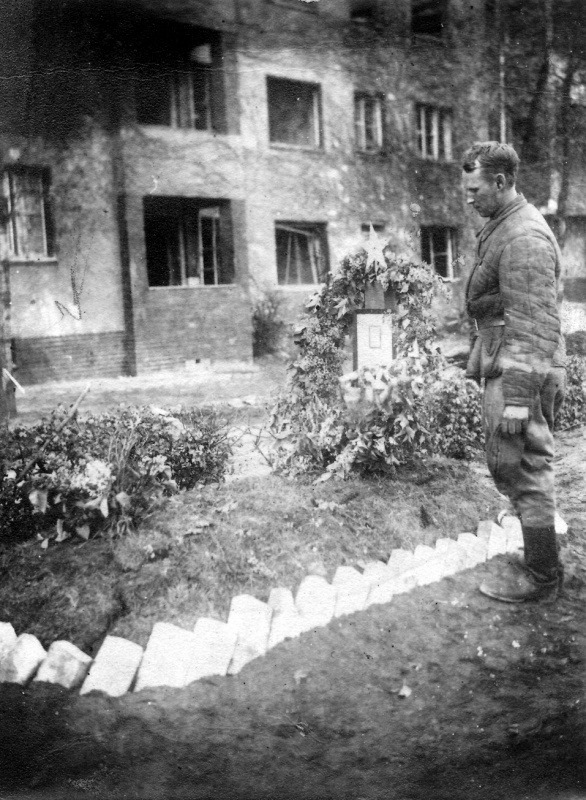
Hitler’s death was eventually announced to the world on May 1st – via a Hamburg radio station broadcast made by Admiral Dönitz. Following funereal music from Wagner and Brückner’s 7th Symphony, the announcement was made that the Führer had ‘fallen at the head of his troops’.
Hours later, an eighteen year old radio announcer named Richard Beier would provide the final broadcast of the Grossdeutscher Rundfunk, headquarter on Masurenallee in Berlin and relayed via a transmitter in the district of Tegel.
Signing off, Beier would announce:
“The Führer is dead. Long live the Reich!”
By nightfall, Soviet soldiers had gathered on Pariser Platz in front of the Brandenburg Gate, where a group of men roasted an ox – and the poet Dolmatovsky stood atop a tank to recite some of his poetry to an enthusiastic audience.
At 10:40pm on May 1st – the 79th Rifle Division picked up a message in Russian transmitted by the LVI German Panzer corps:
“Hello, hello. This is the LVIth German Panzer Corps. We ask you to cease fire. At 0500 hours Berlin time we are sending envoys to parley at the Bendlerstrasse Bridge. The recognition sign is a white flag with a red light. We await your reply.”
General Weidling – commander of the Berlin Defence Area – was about to end the battle.
**
Our Related Tours
Want to learn more about the Battle of Berlin? Check out our Battle of Berlin tours to explore what remains of this important urban battlefield.
To learn more about the history of Nazi Germany and life in Hitler’s Third Reich, have a look at our Capital Of Tyranny tours.
Bibliography
Beevor, Antony (2003) Berlin: The Downfall 1945 | ISBN 978-0-14-028696-0
Hamilton, Aaron Stephan (2020) Bloody Streets: The Soviet Assault On Berlin | ISBN-13 : 978-1912866137
Kershaw, Ian (2001) Hitler, 1936–1945: Nemesis | ISBN 0-393-04994-9
Le Tissier, Tony (2010) Race for the Reichstag: the 1945 Battle for Berlin | ISBN: 978-1848842304
Le Tissier, Tony(2019) SS Charlemagne: The 33rd Waffen-Grenadier Division of the SS | ISBN: 978-1526756640
Mayo, Jonathan (2016) Hitler’s Last Day: Minute by Minute | ISBN: 978-1780722337
McCormack, David (2017) The Berlin 1945 Battlefield Guide Part I the Battle of the Oder-Neisse | ISBN: 978-1781556078
McCormack, David (2019) The Berlin 1945 Battlefield Guide Part II The Battle of Berlin | ISBN: 978-1781557396
Moorhouse, Roger (2010) Berlin at War | ISBN: 978-0465028559
Ryan, Cornelius (1966) The Last Battle | ISBN 978-0-671-40640-0
Sandner, Harald (2019) Hitler – Das Itinerar, Band IV (Taschenbuch): Aufenthaltsorte und Reisen von 1889 bis 1945 – Band IV: 1940 bis 1945 | ISBN: 978-3957231581
Shirer, William L. The Rise and Fall of the Third Reich | ISBN 978-1451651683.

